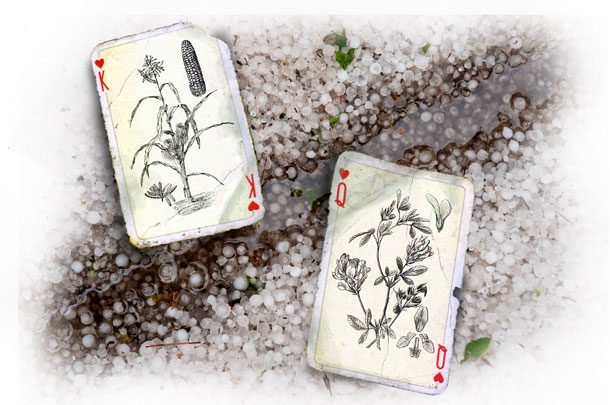Cows were designed as a vessel to turn forage into milk or meat. Unfortunately, that means we can’t just go out and buy tons of commodities to make up for these forage shortages. Cows need forage.
Before we throw our arms in the air and cry, “Why me?” here are the options for dealing with forage shortages:
- Not feed (well, not really an option)
- Buy feed (not practical)
- Steal feed (not advised)
- Turn cows out on the neighbor (not a good idea)
- Plant quick-turnaround emergency forages (the only real option)
Growing emergency forages can be addressed quickly with a fairly broad stroke by taking a systematic look at the options: spring-planted forages, summer annuals and mixes. It is always safe to start with a few ground rules:
- Don’t skimp on seed quality or quantity.
- Consult your herbicide notes or applicator to determine if there could be a residual effect.
- Make sure you bring your nutritionist into the conversation early; nobody likes surprises, and they may have more experience feeding one forage option over another.
- Don’t fudge planting dates. Planting too early or too late can only complicate matters. It is more cost-effective to be a good manager than [to be] the first in the field.
Spring planting
Forage oats are a great choice for a quick-turnaround harvest. (Notice I said forage oats.) Buy oats selected for high forage quality. If you can get in early, adding peas to this mix can increase yield and quality. Plant this mix at one-thirds peas and two-thirds forage oats. As the season gets later, planting only oats is pertinent as the peas struggle in warmer weather. Harvest is going to be close to 60 days post-emergence. This is a one-harvest crop to be followed up by a “summer” planting.
Planting spring triticale is another possibility. There are a few different schools of thought with triticale. It can usually be harvested within 50 to 60 days, if taken in the flag leaf stage to capture high-quality fiber and high sugar content. Others have harvested triticale in the soft dough stage (which will take a few days longer than the standard harvest timeline), leading to increased yield and energy. However, this later stage decreases fiber quality. Harvesting later could prove prosperous for those whose corn silage crop was left wanting. After harvest, one can plant a summer annual or summer mix.
One planting mix (like triticale, Italian rye and red clover) could be planted early in the spring and cut several times throughout the growing season. The upside: only one trip to the field for planting. First cutting should be taken when the triticale is in the flag leaf stage.
Spring barley earns an honorable mention. This crop is starting to catch on in some areas of the country and could help compensate for farms that have good quality hay on hand but need a more energy-dense feedstuff. One drawback is the lack of forage-specific spring barley varieties on the market.
Summer planting
Shorter-season corn is a good choice after a spring crop if the growing window is long enough and feed inventories are not depleted. It’s referenced as “shorter season” because, depending on your location, this may mean moving from 115-day corn to 105, or from 100-day corn to sub-90-day. The drawback: This will limit the amount of manure that can be applied during the growing season.
Sorghum-sudangrass (SS) is a perfect option for operations that are low on feed inventories. Planting SS allows for high-quality feed in a quick turnaround and several cuttings. These days, there are several quality varieties that far exceed the gangly stuff we remember Grandpa planting. Dwarf BMR varieties even exist in this category.
BMR millet is a product some are turning to as a viable summer annual. There have been many improvements to millet over the last few years. With 45 days to first cutting and no problems with prussic acid, taking a look at millet is worthwhile. Like SS, make sure soils are 60 degrees and rising before planting.
Annual mixes are gaining ground as viable options to take advantage of variable growing conditions. A mix of sorghum, Italian rye and clover has shown great promise for exceptional yield and quality. A mix like this can be harvested in as little as 45 days with subsequent harvests every 30 days or so. One benefit of this system is that when it is hot and dry, the sorghum thrives, but if it turns cool, the Italian rye and clover prosper. Mixes like this have been seen to yield 5 to 6 tons of dry matter (TDM) per acre, over three cuttings.
Fall planting forages after these summer annuals, or after spring plants have run their race, can help add to the feed pile. Forage oats, triticale and ryegrass are all options, among others, for fall planting. In some cases, those who are willing to take on three plantings can see exceptional yields of up to 12 TDM an acre – 3 tons DM in the spring and 6 tons in the summer, followed by 3 more tons in the fall. That rivals, and exceeds, many corn silage acre plantings.
Operations seeking additional forage for one reason or another have a plethora of crop choices to fill in the gap, realizing that each region has its own nuances and timing considerations. It is easy to get focused on only corn and alfalfa with their consistent quality, high yield and familiar management practices. But when the king is dead and the queen is gone, we have to look outside the box to make up the difference. ![]()
ILLUSTRATION: Illustration by Corey Lewis.

-
Mark Kirk
- Business Development and Customer Relations Manager
- Rock River Laboratory
- Email Mark Kirk











